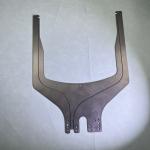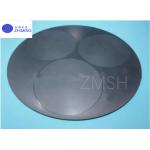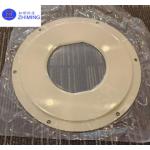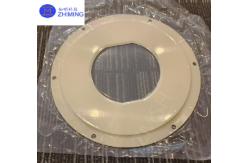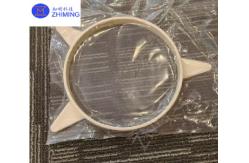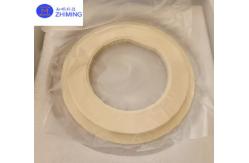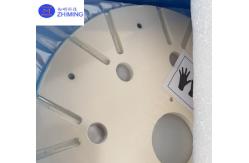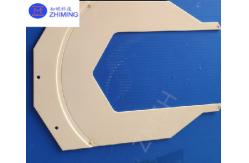Alumina Ceramic/Mechanical Arm/Suction Cup/Ceramic Structural
Parts Al2O3
Abstract
Aluminum oxide ceramics (Al₂O₃), also known as alumina ceramics,
are widely recognized for their excellent physical and chemical
properties, including high hardness, wear resistance, corrosion
resistance, and thermal stability. These features make alumina
ceramics highly suitable for use in a variety of industrial
applications, especially in robotic arms, suction cups, and other
structural ceramic components.
Properties of Aluminum Oxide Ceramics
Aluminum oxide ceramics(Al₂O₃) possess numerous outstanding
properties, which make them a preferred material for various
high-performance applications. The primary characteristics of
aluminum oxide ceramics are as follows:
1. High Hardness
Aluminum oxide ceramics (Al₂O₃)are extremely hard, second only to
diamond. This high hardness gives alumina ceramics exceptional wear
resistance, making them ideal for use in environments where
friction and abrasion are prevalent. For example, components such
as bearings, gears, and seals that experience continuous wear
benefit greatly from the hardness of aluminum oxide.
2. High Temperature Resistance
Aluminum oxide ceramics (Al₂O₃)exhibit excellent thermal stability
and can withstand high temperatures without deforming or degrading.
With a melting point of around 2050°C, alumina ceramics are ideal
for use in high-temperature environments such as metallurgy,
ceramics, and chemical industries. Their thermal resistance makes
them suitable for components that must operate in extreme heat
conditions.
3. Corrosion Resistance
Aluminum oxide ceramics (Al₂O₃)have remarkable chemical resistance,
making them highly resistant to attack from acids, alkalis, and
other corrosive substances. This property is essential in
industries such as chemicals, pharmaceuticals, and food processing,
where equipment is often exposed to aggressive chemicals.
2. Applications of Aluminum Oxide Ceramics in Robotic Arms
Robotic arms are essential in modern automation, used in tasks such
as assembly, welding, material handling, and packaging. Aluminum
oxide ceramics(Al₂O₃) are particularly valuable in robotic arms due
to their hardness, wear resistance, and high thermal stability.
Some common applications of aluminum oxide ceramics in robotic arms
include:
1. Wear-resistant Components
Robotic arms are often used in high-friction environments, where
components like bearings, gears, and sliding surfaces are subject
to constant wear. Aluminum oxide ceramics(Al₂O₃) are ideal for
these applications because of their exceptional hardness and wear
resistance. Components such as the arm joints, end effectors, and
mechanical manipulators can be made from alumina ceramics to
increase the longevity of the robotic arm.
2. High-temperature Applications
Certain robotic arms are employed in high-temperature environments,
such as metal welding, furnace loading, or glass manufacturing. In
these cases, aluminum oxide ceramics(Al₂O₃) are used in the
construction of high-performance robotic arm parts. Their ability
to withstand extreme temperatures without losing strength or shape
makes them essential in industries where other materials might
degrade or fail under heat stress.
3. Electronic Components
Modern robotic arms are highly integrated with advanced electronic
systems, including sensors, actuators, and control units. The
electrical insulating properties of aluminum oxide ceramics make
them an ideal material for electronic components in robotic arms,
such as insulating casings, electrical connectors, and PCB
substrates. These components ensure that the robotic arms can
operate safely in complex electrical systems while maintaining
reliability.
3. Applications of Aluminum Oxide Ceramics in Suction Cups
Suction cups are widely used in automated assembly lines and
industrial processes for lifting and handling objects. They are
often made from soft materials like rubber or silicone, which can
wear out or deform under extreme conditions. Aluminum oxide
ceramics are increasingly being used in suction cups to improve
their durability and performance in harsh environments. Below are
the main advantages of using alumina ceramics in suction cups:
1. Wear Resistance
Suction cups are frequently used in high-friction applications, and
wear resistance is a critical factor in determining their lifespan.
Aluminum oxide ceramics’ exceptional hardness makes them ideal for
use in suction cups, as they can withstand prolonged wear without
degrading or losing their functionality. This is particularly
important in industries such as automotive manufacturing and
material handling, where suction cups are exposed to frequent use.
2. High-temperature Resistance
Many industrial processes, such as metal fabrication or glass
production, require the handling of hot objects. Traditional
suction cups made from soft materials can fail when exposed to high
temperatures. In contrast, aluminum oxide ceramics can perform at
high temperatures without deforming, making them suitable for
applications where the suction cup needs to handle heated objects.
3. Chemical Resistance
Suction cups may come into contact with various chemicals,
including acids, solvents, and oils, depending on the application.
Aluminum oxide ceramics are highly resistant to chemical corrosion,
making them ideal for use in environments where traditional
materials might break down due to chemical exposure. Their ability
to maintain their integrity in aggressive chemical environments
makes them a preferred choice for chemical processing and
pharmaceutical industries.
4. Lightweight Design
Although aluminum oxide ceramics are dense, their
strength-to-weight ratio allows for the design of lightweight
suction cups that do not place undue strain on robotic arms or
material handling systems. Lightweight suction cups are beneficial
for improving the efficiency of automation systems while
maintaining optimal lifting performance.
4. Applications of Aluminum Oxide Ceramics in Structural Ceramic
Components
In addition to their use in robotic arms and suction cups, aluminum
oxide ceramics are widely used in other structural components that
require high strength, wear resistance, and chemical stability.
Some common applications of alumina ceramics in structural
components include:
1. Wear-resistant Linings
In industries such as mining, metallurgy, and chemicals, equipment
and machinery often have to withstand abrasive wear from
particulate matter. Aluminum oxide ceramics are frequently used as
wear-resistant linings in equipment such as chutes, hoppers, and
cyclones, which are exposed to high-impact and abrasive
environments. The hardness and wear resistance of aluminum oxide
ceramics ensure that these components last longer and perform
reliably under harsh conditions.
2. Seals and Gaskets
Alumina ceramics are often used in the production of seals and
gaskets that need to perform in high-temperature or chemically
aggressive environments. Aluminum oxide ceramics provide excellent
sealing properties while resisting degradation from heat, pressure,
and corrosive substances. This makes them ideal for applications in
industries such as petrochemical processing and power generation.
3. Valve and Pipe Components
In high-pressure and high-temperature systems, aluminum oxide
ceramics are used in valves, pipes, and other structural components
to ensure durability and longevity. The chemical and wear
resistance of alumina ceramics ensures that these components can
handle harsh fluids and gases without corroding or degrading over
time.
Q&A
Q:What are the Common Aluminum Oxide Ceramic Structural
Components?
A:1. Industrial Components
Bearings: Used in high-speed rotating equipment for their wear resistance
and corrosion resistance.
Sealing Rings and Seals: Prevent leakage in chemical equipment and pumps.
Cutting Tools: Suitable for cutting metals, fibers, or other hard materials.
2. Electronic Components
Insulators: Used in high-voltage electrical equipment and electronic devices
for insulation.
Substrates: Applied in electronic circuits, integrated circuits, and LED
packaging.
Sensor Housings: Protect sensitive components from environmental damage.
3. Medical Devices
Surgical Blades: Provide extreme sharpness and durability for medical surgeries.
Prosthetic Materials: Such as hip joints and dental implants, valued for their
biocompatibility and high strength.
4. Mechanical Equipment Parts
Wear-Resistant Pipes: Used for transporting abrasive materials in mining and power
plants.
Nozzles: Ideal for sandblasting, spraying, and other high-wear
applications.
Valve Components: Resistant to corrosion and capable of withstanding high
temperatures and pressures.
Tag:#Alumina Ceramic #Mechanical Arm
#Suction Cup #Ceramic Structural Parts
